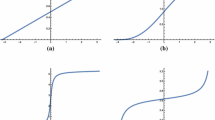Abstract
Procedures for detecting an initial transient in simulation output data are developed. The tests use the second-order cumulant spectrum which differs from the power spectrum in that the stationarity constraint is not required for the former. The second-order cumulant spectrum can be interpreted as the nonstationary power spectrum and is an orthogonal decomposition of the variance of a nonstationary process. The null hypothesis is that the simulation output data series is a covariance stationary process. Equivalently, all estimates of the second-order cumulant spectrum in the region which excludes the estimates of the power spectrum will have an expected value of zero. The test procedures are designed to detect initialization bias in the estimation of the mean and the variance. These procedures can be extended to detect bias in the moments of cumulants of ordern, wheren>2. Results are presented from the application of the test to simulated processes with superimposed mean and variance transients and anM/M/1 queue example.
Similar content being viewed by others
References
R. Abraham, J.E. Marsden and T. Ratiu,Manifolds, Tensor Analysis, and Applications (Addison-Wesley, Reading, MA, 1983).
N. Bloomquist, On the transient behavior of theGI/G/1 waiting-times, Skand. Aktuarietidskr. 53(1970)118–129.
P. Bratley, B.L. Fox and L.E. Schrage,A Guide to Simulation, 2nd ed. (Springer, New York, 1987).
D.R. Brillinger, An introduction to polyspectra, Ann. Math. Statist. 36(1965)1351–1374.
D.R. Brillinger,Time Series, Data Analysis and Theory, expanded edition (Holden-Day, San Francisco, 1981).
J.W. Dalle Molle, Higher-order spectral analysis and the trispectrum, Ph.D. Dissertation, Department of Management Science and Information Systems, The University of Taxas at Austin (1992).
J.W. Dalle Molle and M.J. Hinich, Trispectral analysis, Technical Report ARL-TP-89-4, Applied Research Laboratories, The University of Texas at Austin (1989).
J.W. Dalle Molle and M.J. Hinich, Cumulant spectra-based tests for the detection of a coherent signal in noise,Proc. Int. Signal Processing Workshop on Higher-Order Statistics (1991) pp. 151–153.
A.V. Gafarian, C.J. Ackner, Jr. and T. Morisaka, Evaluation of commonly used rules for detecting “steady state” in computer simulation, Naval Res. Logist. Quart. 25(1978)511–529.
J.W. Goodman,Statistical Optics (Wiley, New York, 1985).
A.C. Harvey,The Econometric Analysis of Time Series (MIT Press, Cambridge, MA, 1990).
P. Heidelberger and P.D. Welch, Simulation run length control in the presence of an initial transient, Oper. Res. 31(1983)1109–1144.
M.J. Hinich, Testing for Gaussianity and linearity of a stationary time series, J. Time Series Anal. 3(1982)169–176.
M.J. Hinich, Detecting a transient signal by bispectral analysis, IEEE Trans. Accoustics, Speech, and Signal Proc. ASSP-38(1990)1277–1283.
M.J. Hinich and C. Clay, The application of the discrete Fourier transform in the estimation of power spectra, coherence, and bispectra of geophysical data, Rev. Geophys. 6(1968)347–363.
M.J. Hinich and M.A. Wolinsky, A test for aliasing using bispectral analysis, J. Amer. Statist. Assoc. 83(1988)499–502.
W.D. Kelton, Random initialization methods in simulation, IIE Trans. 21(1989)355–367.
M.G. Kendall and A. Stuart,The Advanced Theory of Statistics, Vol. 1 (Griffin, London, 1958).
A.M. Law and W.D. Kelton,Simulation Modeling and Analysis, 2nd ed. (McGraw-Hill, New York, 1991).
V.P. Leonov and A.N. Shiryaev, On a method of calculation of semi-invariants, Theory Prob. Appl. 4(1959)319–328.
J.R. Murray and W.D. Kelton, Initializing for bias reduction: Some analytical considerations, in:Proc. 1988 Winter Simulation Conf. (1988) pp. 546–548.
M. Rosenblatt,Stationary Sequences and Random Fields (Birkhäuser, Boston, 1985).
SAS Institute, Inc.,SAS/GRAPH® User's Guide, Version 5 (SAS Institute, Inc., Cary, NC, 1985).
H. Scheffe,The Analysis of Variance (Wiley, New York, 1959).
L.W. Schruben, Detecting initialization bias in simulation output, Oper. Res. 30(1982)569–591.
L.W. Schruben and D. Goldsman, Initialization effects in computer simulation experiments, Technical Report No. 594, School of Operations Research and Industrial Engineering, Cornell University, Ithaca, NY (1985).
L.W. Schruben, H. Singh and L. Tierney, Optimal tests for initialization bias in simulation output, Oper. Res. 31(1983)1167–1178.
A.N. Shiryaev,Probability (Springer, New York, 1984).
P.D. Welch, The statistical analysis of simulation results, in:Computer Performance Modeling Handbook (Academic Press, New York, 1983).
W. Whitt, Planning queueing simulations, Manag. Sci. 35(1989)1341–1366.
J.R. Wilson and A.B. Pritsker, Evaluation of startup policies in simulation experiments, Simulation 31(1978)79–89.
J.R. Wilson and A.B. Pritsker, A survey of research on the simulation startup problem, Simulation 31(1978)55–58.
Author information
Authors and Affiliations
Rights and permissions
About this article
Cite this article
Dalle Molle, J.W., Morrice, D.J. Initial transient detection in simulations using the second-order cumulant spectrum. Ann Oper Res 53, 443–470 (1994). https://doi.org/10.1007/BF02136838
Issue Date:
DOI: https://doi.org/10.1007/BF02136838




